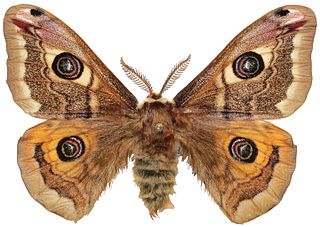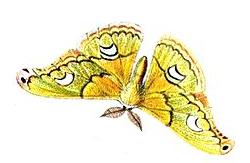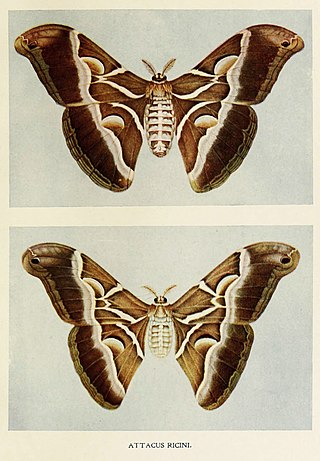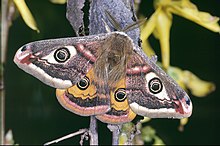
Saturniidae, members of which are commonly named the saturniids, is a family of Lepidoptera with an estimated 2,300 described species. The family contains some of the largest species of moths in the world. Notable members include the emperor moths, royal moths, and giant silk moths.

Saturnia pavonia, the small emperor moth, is a moth of the family Saturniidae. It was first described by Carl Linnaeus in his 1758 10th edition of Systema Naturae. Sometimes, the incorrect genus name Pavonia is still used for this species. This moth occurs throughout the Palearctic region and is the only member of its family to be found in the British Isles, where it is usually called simply the emperor moth.

Saturnia is a genus of large moths in the family Saturniidae, which the German biologist Franz Paula von Schrank first described in 1802. Its members are commonly named emperor moths, though this is also used for various close relatives in subfamily Saturniinae. Most species are Palearctic, but three, commonly called saturnia moths, inhabit the chaparral of California: S. mendocino, S. walterorum, and S. albofasciata.

The Saturniinae or saturniines are a subfamily of the family Saturniidae. They are commonly known as emperor moths or wild silk moths. They are easily spotted by the eyespots on the upper surface of their wings. Some exhibit realistic eye-like markings, whilst others have adapted the eyespots to form crescent moon or angular shapes or have lost their wing scales to create transparent windows. They are medium to very large moths, with adult wingspans ranging from 7.5 to 15 cm, in some cases even more. They consist of some of the largest sized Lepidoptera, such as the luna moth, atlas moth, and many more. The Saturniinae is an important source of wild silk and human food in many different cultures.

Saturnia zuleika is a moth of the family Saturniidae. It is found in India and West Bengal.

Saturnia spini, the sloe emperor moth, is a moth of the family Saturniidae. The species was first described by Michael Denis and Ignaz Schiffermüller in 1775. It is found from eastern Austria and Poland across eastern and south-eastern Europe to Greece, Turkey, Armenia, Ukraine, and Kazakhstan.

Saturnia pavoniella is a moth of the family Saturniidae. It is found in the alpine regions of Austria, Italy and the Czech Republic across south-eastern Europe to northern Turkey and the Caucasus. It is possibly also present in south-eastern France.

Perisomena is a genus of moths in the family Saturniidae.

Samia canningi is a moth of the family Saturniidae. It is found in south-eastern Asia and China.
Agapema is a subgenus of moths under the genus Saturnia, in the family Saturniidae. Agapema was first described by Berthold Neumoegen and Harrison Gray Dyar Jr. in 1894.

Rinaca is a genus of moths in the family Saturniidae erected by Frederic Moore in 1862. It is often treated as a subgenus of Saturnia.
Calosaturnia is a genus of moths in the family Saturniidae first described by Smith in 1886. The genus is sometimes included in Saturnia.

Copaxa sapatoza is a species of moth in the family Saturniidae first described by John O. Westwood in 1854 as Saturnia sapatoza. It is found in the north-east of the Andean Cordillera in Colombia at high elevations.
Saturnia mendocino, the Mendocino saturnia moth, is a species of silkmoth in the family Saturniidae. It was first described by Behrens in 1876 and it is found in North America.
Saturnia albofasciata, the white-streaked saturnia moth, is a species of silkmoth in the family Saturniidae.
Saturnia walterorum, or Walter's saturnia moth, is a species of silkmoth in the family Saturniidae. It is found in Central America and North America.

Samia ricini, the Eri silkmoth, is a species of insect, a member of the family Saturniidae which includes the giant silk moths. This moth is a domestic polyhybrid that has been bred for centuries due to the silk it makes. The name is based on the host plant used for feeding the caterpillars, castor, Ricinus communis. This moth is derived from several different species within the genus including Samia cynthia and Samia canningi.











